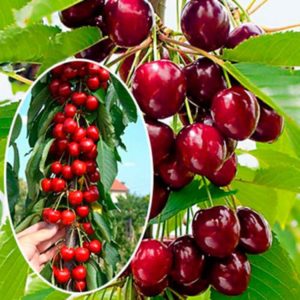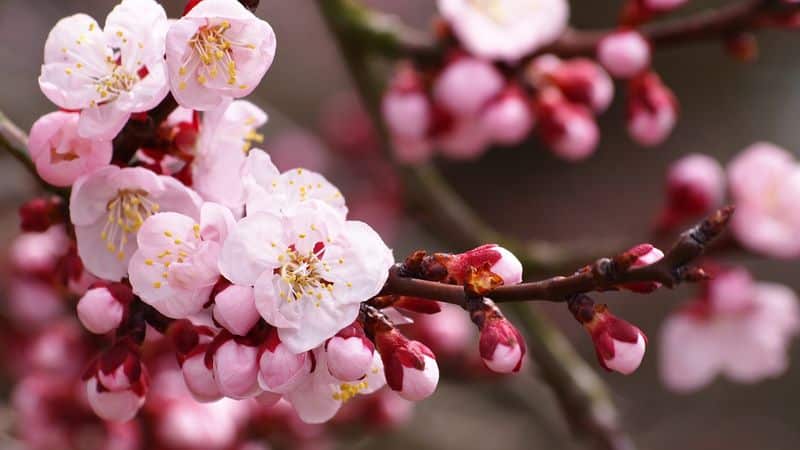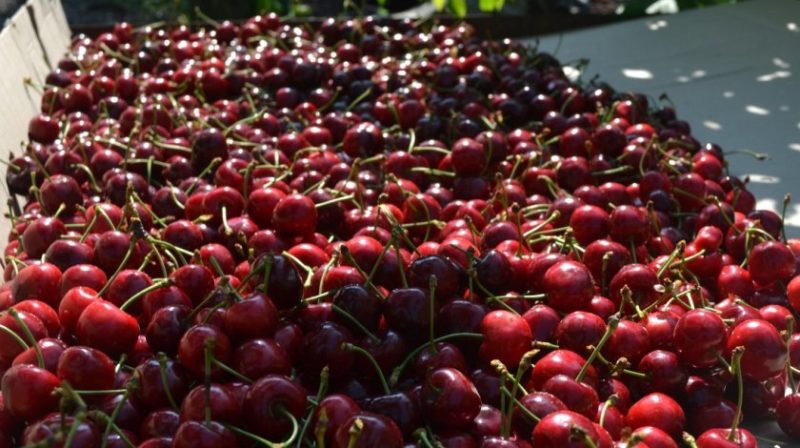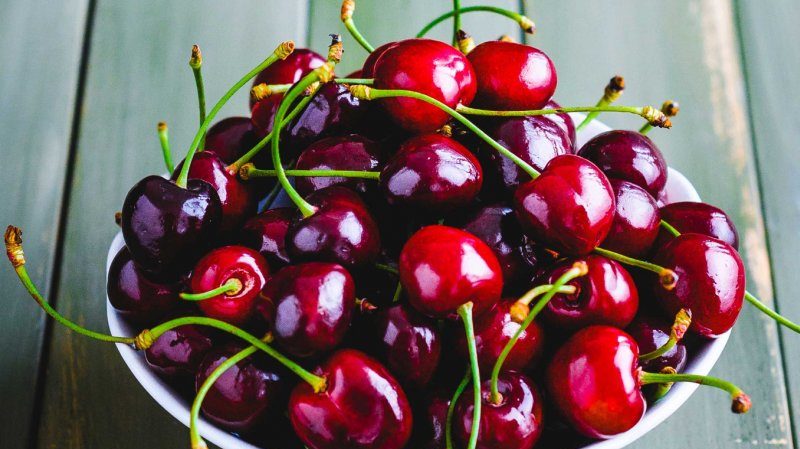Large-fruited, unpretentious variety of columnar cherries “Silvia”
Sylvia is one of the most popular varieties of columnar cherries. The crop is grown not only on an industrial scale, but also on personal plots. The article will tell you about the positive and negative characteristics of the variety, requirements for cultivation and nuances of care.
Description and characteristics of the cherry variety
Sylvia is a columnar cherry variety bred in Canada in 1988 by scientists K. Lapins, D. Jefferson and D. Lane as a result of crossing the Lambert Compact and Van varieties.
Suitable for cultivation in the southern part and central zone of Russia, Ukraine and southern Belarus. Provided the trees are insulated for the winter cultivation is possible in more northern regions.
Description of the tree and fruit, taste
Wood characteristics:
- height up to 3 m even on wild rootstock;
- straight trunk with practically no side branches;
- vertically growing shoots;
- a dense cylindrical crown that requires almost no shaping.
The berries are large, up to 3 cm in diameter, with an average weight of 10-12 g, covered with a glossy, dense, dark red peel that is not subject to cracking. The flesh is deep red with pink veins, juicy, dense and crisp, characterized by a bright, sweet, honey taste.
Frost resistance and drought resistance
The variety tolerates air temperatures down to -28°C, and during flowering - down to -2°C.
In case of drought, trees continue to develop, but the lack of moisture negatively affects the quality and quantity of the harvest.
Variety resistance to diseases and pests
The variety is resistant to pest attacks and various diseases, including fungal ones.
Pollinator varieties
This is a self-sterile variety, so several other varieties of cherries are planted nearby for fruit set and yield. Best pollinators for Sylvia:
- Cordia;
- Lapins;
- Regina;
- Helena;
- Sam;
- Hedelfinger;
- Reinier;
- Ulster;
- Vega;
- Samburst.
Flowering and ripening period, yield

The flowering period occurs in May, the berries ripen in the first half (12-18th) of June.
Fruiting begins 2-3 years after landings seedlings and lasts for 7-10 days. At the 3rd year of plant life, the yield is about 15 kg of berries; older trees produce 50 kg of fruit each. Due to the high yield, the lifespan of trees is a maximum of 15 years.
Reference. In years 1 and 2, all ovaries are removed from the seedlings. This promotes better rooting, since the tree does not waste energy on ripening the fruits.
Advantages and disadvantages
The main advantages of the variety include:
- compactness;

- decorative appearance;
- large fruit;
- excellent berry taste;
- frost resistance;
- ease of care.
Among the disadvantages of Sylvia are:
- intolerance to strong and cold winds;
- average degree of resistance to prolonged drought and excessively wet soil;
- need for abundant sunlight;
- impossibility of growing near tall plants.
Planting seedlings
Cherry Sylvia grows well in light, loose soil with good aeration and moisture permeability. The best option is sandy loam, coarse sandy and loamy soils.
For planting, choose a well-lit place, protected from gusty cold winds, with a deep (at least 2 m) level of groundwater, located on a hill.
Important! The variety does not like transplanting, especially during the first 3-4 years.
When choosing planting material, they give preference to 1- or 2-year-old seedlings with a straight trunk, smooth bark, a living and intact bud of the upper shoot, a developed root system without signs of rotting and tissue death.
Instructions for planting seedlings of this variety
Most often, especially in the northern regions, cherries are planted in the spring (April - May), when the risk of return frosts has passed. In this case, the seedlings will have time to take root before the onset of frost.
Reference. Autumn (late September - early October) planting is permissible only in the southern regions, where the plant has time to take root and adapt before the onset of cold weather.
Landing instructions:
- A week before planting seedlings, clear the selected area of plant debris.
- Dig planting holes on it 60-80 cm deep and 80 cm wide.
- Pour into each nutritious soil mixture, consisting of dug up fertile soil, 3-5 buckets of rotted manure, 210 g of phosphorus-potassium fertilizers and 1 bucket of river sand.
- Water the holes generously at the rate of 2 buckets of water for each.
- After 7 days, pour a solution of a growth stimulator (“Kornevin”, “Heteroauxin”) into each hole.
- Drive a wooden stake into the center so that it rises 50 cm above the ground.
- Form a mound of nutritious soil mixture in the hole.
- Place a seedling on it, carefully spread its roots along the slopes.
- Sprinkle the roots with soil so that it fills all the voids and the root collar rises 2-3 cm above the ground.
- Tie the trunk to the support.
- Compact and water the soil, cover it with a 5 cm layer of mulch.
Due to the compactness of the trees, dense planting is possible with a distance between trees of 1 m.
Read also:
Subtleties of further care
Cherry Sylvia does not require labor-intensive care. Agricultural technology comes down to regular watering and fertilizing of plants, as well as pruning.

Watering intensity
This is a moisture-loving crop: watering is especially important during fruit ripening. During the first 2 years of life, trees are watered as the soil dries out. 3-5 liters of water are poured under each tree. As plants age, the amount of moisture they need increases proportionally.
Soil fertilization
Fertilizers are applied once a year. Young trees are fed by adding 15-20 g of phosphorus and potassium mixed with humus for each. Adults need 50 g of complex mineral fertilizers (ammophoska, diammofoska, azofoska).
Pruning and crown formation
Despite the fact that Sylvia does not need serious pruning, it is important to give the crown the correct shape and direct the branches in the right direction.
In the first year after planting, the tops of the trees and their side shoots are shortened to a length of 10 cm. The next year, the branches are shortened so that 20 cm remain on the side shoots, and 30 cm on the top. After another 1 year, 30 cm are left.
Reference. As soon as the tree reaches a height of 2.5 m, the top is pinched to stop further growth.
Disease and pest control
Cherry Sylvia has strong immunity to diseases and pests. To enhance the stability of trees, they are sprayed with Bordeaux mixture before the flowering period begins, and the trunks are whitened with lime.
Harvest and storage

The harvest is harvested in mid-June. The berries are picked together with the “tails” first from the lower branches and gradually move to the upper ones.
The fruits are not prone to cracking, tolerate transportation well and are stored without refrigeration for 7-10 days, in the refrigerator for about 3 weeks.
Reviews from gardeners

Gardeners who grew Sylvia cherries have mixed opinions about them. On specialized forums there are both positive and negative reviews.
Lyudmila, Sevastopol: “We planted several varieties columnar cherries - Sylvia and Helena. They have been growing with us for 4 years. They took it well, never got sick during this time, and there were no pests either. We have to water frequently and abundantly, because our climate is hot and dry. The berries are tasty and large. We were told that they would be the same, but it seems to me that Sylvia is still sweeter and larger-fruited. In the first year of fruiting, we collected a bucket of berries from each tree.”
Anatoly, Svetlograd: “I planted Sylvia and Sam at the dacha, they bore fruit perfectly for 3 years, I was pleased, but then Sylvia began to grow strongly to the sides, even the top. On forums on the Internet they advised to prune. This year I did everything as recommended, but after that the yield dropped significantly.”
Conclusion
Compact trees of columnar cherry varieties are increasingly found on gardeners’ personal plots. A clear confirmation of this is the Sylvia variety, which is loved by summer residents due to its frost resistance, ease of care, high yield and large, tasty and sweet berries.